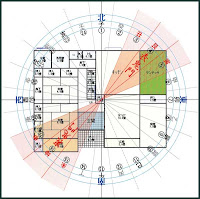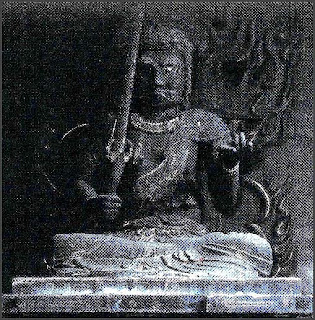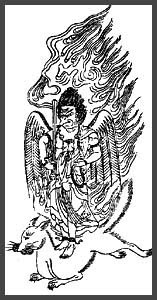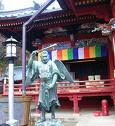[ . BACK to DARUMA MUSEUM TOP . ]
:::::::::::::::::::::::::::::::::::::::::::::::::::::::::::::::::::::::::::::::::::::::::::::::::::::
Fukagawa Fudo Do (Fudoo Doo) 深川不動堂
The Fudo Hall in Fukagawa was the "Edo Branch" of the famous Fudo in Narita.
This temple is Nr. 12 in the Kanto Fudo Pilgrimage.
Fukagawa no O-Fudo san 深川のお不動さん
関東三十六不動霊場二十番札所 Nr. 20 of the pilgrimage
. Pilgrimage to 36 Fudo Temples in Kanto / Bando .
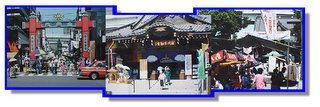 http://www.asahi-net.or.jp/~qr2m-skmt/f102.htm
http://www.asahi-net.or.jp/~qr2m-skmt/f102.htm
 source : facebook
source : facebook
:::::::::::::::::::::::::::::::::::::::::::::::::::::::::::::::::::::::::::::::::::::::::::::::::::::
. Onegai Fudoo おねがい不動さま / お願い不動
Onegai Fudo Sama - Fudo to make a wish .
Built as a
chokugan-ji on order of 嵯峨天皇 Saga Tenno (786 - 842) by Kobo Daishi.
. Chokuganji 勅願寺 Chokugan-Ji, "Imperial Temple" .
:::::::::::::::::::::::::::::::::::::::::::::::::::::::::::::::::::::::::::::::::::::::::::::::::::::
Quote:
Stretching out in front of Monzen-Nakacho Station on the Tozai subway line is a long, bustling road. Along the way are the grounds where the temple
Eidaiji once stood. The temple Naritasan Shinshoji in Chiba began lending a statue of the deity Fudo Myoo to Eidaiji in 1703, a practice it continued nearly every year.
Many people gathered to worship each time the statue was placed on display, and there were calls to make the display permanent. In the Meiji era (1868-1912) a replica of the Fudo Myoo statue was brought from Naritasan Shinshoji, and Fukagawa Fudodo was established on the grounds of Eidaiji to house it.
On the first, fifteenth, and twenty-eighth of every month, many people gather as dozens of food stalls are set up along the street leading to the temple. This street is lined on both sides with long-established shops selling such familiar products as tsukudani (food boiled down in soy sauce) and traditional sweets. This is a perfect place to get a taste of Shitamachi.
http://web-japan.org/tokyo/tips/sumida_tour/sumida_cont2.html
:::::::::::::::::::::::::::::::::::::::::::::::::::::::::::::::::::::::::::::::::::::::::::::::::::::
Quote:
If visiting Fukagawa on an ordinary day, a stopover at Fukagawa Fudo temple near Exit 1 of Monzen Nakacho Station is well worth it. A branch of the great Narita Fudo in Chiba Prefecture, Fukagawa Fudo is housed in an Edo-period building moved from Chiba; it's not large, but is impressively decorated with carvings and handsome beams. You may enter the main hall when it is not used for services.
The Fudo temple first started renting a corner of Eitai-ji, an influential temple which held sway over most of southern Fukagawa and was closely affiliated with
Tomioka Hachiman-gu since the 17th century. After the 1868 ordinance to separate the two religions, Eitai-ji suffered a rapid decline, while the Fudo temple flourished, riding on the patronage of Fudo temples by
Kabuki actor Danjuro (Danjuuroo 団十郎).
By SUMIKO ENBUTSU
The Japan Times: Aug. 5, 2005
http://search.japantimes.co.jp/print/features/enviro2005/fe20050805se.htm
. Gofunai Nr. 68 - Eitaiji 永代寺 Eitai-Ji .
and Tomioka Sumo monuments
Jinmaku Kyuugoroo 陣幕久五郎 Jinmaku Kyugoro (1829 - 1903)
:::::::::::::::::::::::::::::::::::::::::::::::::::::::::::::::::::::::::::::::::::::::::::::::::::::::
:::::::::::::::::::::::::::::::::::::::::::::::::::::::::::::::::::::::::::::::::::::::::::::::::::::::
Fukagawa osame no Fudo 収めの不動
Osame no fudo (year-end fairs) can be found all over town, but the one to watch for this Dec 28 is held at Fukagawa Fudo Temple in downtown Monzennakacho. Check out the souvenir shops that line the street leading to the temple, and try some traditional Japanese confectionery or the local specialty, fukagawa-meshi (steamed rice mixed with clams). With next year being the 300th anniversary of the temple, there痴 sure to be plenty going on.
1-17-13 Tomioka, Koto-ku. Tel: 03-3641-8287. Nearest stn: Monzen nakacho.
http://metropolis.japantoday.com/tokyofeaturestories/404/tokyofeaturestoriesinc.htm
............................... Osame-Fudo is a kigo for Winter.
http://worldkigo2005.blogspot.com/2005/01/saijiki-of-buddhist-events.html
:::::::::::::::::::::::::::::::::::::::::::::::::::::::::::::::::::::::::::::::::::::::::::::::::::::
Amulets from Fukagawa Fudo 御守り


Blue Fudo

waraji わらじお守り
straw sandal amulets

goma seihai 護摩聖灰
sacred ashes from a Goma fire ritual
The temple has fire rituals five times a day. The ashes are put in five envelops with different colors, for the Fudo of Five Colors (Goshiki). The envelops are hung up at the ceiling of the home
to prevent fire.
. 江戸の五色不動明王 Goshiki Fudo of Edo .
source : www.omairibiyori.com
:::::::::::::::::::::::::::::::::::::::::::::::::::::::::::::::::::::::::::::::::::::::::::::::::::::
Close by is Tomioka Hachimangu.
see below.
gankake kitsune 願掛けきつね fox to make a wish

The
Fukagawa Shusse Inari shrine 深川出世稲荷
is in the compound of the temple.
After having received a flint for the New Year fire (kriibi 切り火 ) people came to this shrine.
They bought this white fox with the wish for a good career. You had to write your wish on a sheet of paper, roll it small and stick it inside the statue of the white fox, which was open at the bottom for this purpose.
Now other people could not read your wish and the statue was safely left at the shrine.
The priest from the tempel would come over and strike the flint two times over the newly offered fox, making a noise like
"katsu katsu" (to win, to win).
Now the pilgrim was ready for the new year, with his emotions well in order to deal with the vicissitudes of life.
:::::::::::::::::::::::::::::::::::::::::::::::::::::::::::::::::::::::::::::::::::::::::::::::::::::
Quote:
真言宗 智山派 深川不動堂
御本尊:大日大聖不動明王(秘仏)
(江戸の成田不動)成田山信仰が降盛となるのは江戸時代初期よりである。元禄頃になると江戸庶民一般、特に花柳界や魚河岸、木場、角力界に普及し、講社を組織して成田山へ登拝することが盛んになった。しかし当時の交通はやはり不便であったから、本山に詣って親しく明王を拝し、お護摩の炎に接したいとの切なる願いを抱いてはいてもその実現は困難であった。
そこでこれらの人々にも親しく明王の威徳に接して護摩の座に列してもらおうと本尊不動明王の御分霊を江戸の地に奉安したいという願望が各講中に起こるに至った。時に元禄十六年(1703)。総勢三百人の行列が成田から江戸まで一週間あまりをかけて御本尊を遷座、富岡八幡宮の別当・永代寺の境内にて成田不動の尊像を一時安置する成田山江戸出開帳が二ヶ月にわたって盛大に威行された。
一説に五代将軍徳川網吉の母・桂昌院が、名高い成田不動尊を江戸にいながらに参詣したいと、時の高僧・隆光に頼み込んで実現したとも伝えられている。
(成田不動堂の誕生)
明治元年(1868)三月二十八日の神仏分離の布告により、富岡八幡社内に留まることが許されなくなると、深川の信徒講社らが大本山に働き掛け、旧来出開帳をしてきた特縁の地である深川富岡八幡神社の別当・永代寺の中にある吉祥院聖天堂に移転する事となった。こうして翌年には御本尊は現在地に遷座せられたのである。明治十一年(1878)には「成田山御旅宿」の宿号を廃して「成田不動堂」と改称し、永代寺跡の現在地に堂宇を着工。明治十四年には深川不動尊を安置する本堂が完成した。
http://www.isbs.co.jp/hudou/hudou20.htm
:::::::::::::::::::::::::::::::::::::::::::::::::::::::::::::::::::::::::::::::::::::::::::::::::::::
WASHOKU : Fukagawa and Food
Fukagawameshi ふかがわめし/ 深川
Rice from Fukagawa
Fukagawa-don, a bowl of rice topped with a miso-based stew of clams (asari) and green onions
Matsuo Basho lived in Fukagawa, on the other bank of the River Sumida.
MORE - hokku about Fukagawa by
. Matsuo Basho 松尾芭蕉 - Archives of the WKD .
Fukagawa nezumi 深川鼠 (ふかがわねずみ) shades of GREY. GRAY and Haiku
.................................................................................
Fudo Myo-O for a good career !
. Shusse Fudoo 出世不動尊 at Fukagawa .
(長専院不動寺)
東京都江東区三好1-6-3
:::::::::::::::::::::::::::::::::::::::::::::::::::::::::::::::::::::::::::::::::::::::::::::::::::::
H A I K U
深川や舟も一組とし忘
Fukagawa ya fune mo hito-gumi toshiwasure
Fukagawa--
on a boat, too, a party
drinks away the year
Kobayashi Issa 一茶
Tr. David Lanoue
.................................................................................
 深川や桃の中より汐干狩
深川や桃の中より汐干狩
Fukagawa ya momo no naka yori shiohigari
Fukagawa !
through the peach blossoms
people are gathering shells
Kobayashi Issa 一茶
shiohigari - gathering shells and small seafood at low tide.
Fukagawa had a great flatland tidal area where people could collect cheap seafood.
:::::::::::::::::::::::::::::::::::::::::::::::::::::::::::::::::::::::::::::::::::::::::::::::::::::
Fukagawa Tomioka Hachimangu 富岡八幡宮
東京都江東区富岡 1-20-3
 www.tomiokahachimangu.or.jp.
www.tomiokahachimangu.or.jp.
The shrine was founded in 1627 with reclamation of the shoal. The God Hachiman whom the shrine reveres was also a local Shinto deity of the Minamoto clan thus the shinto shrine received cordial protection by the Tokugawa shogunate. On other hand, the shrine was cordinal revered from the people of shitamachi, and familiar as "Hachiman of Fukagawa".
At the Meiji period, the shrine lost the cordial protection like Edo period, but was chosen as Tokyo Ten Shrines (東京十社, Tokyo Jissha) by the Meiji government though it was the one inferior to
Hikawa Shrine and other major shrines in the status that the government had provided.
Tomioka Hachiman Shrine is also known as the birthplace of Kanjin-zumō (勧進相撲), founded in 1684 and origin of the current professional sumo.
... In 1900 (Meiji 33), the stone monument to commend successive yokozuna, the Yokozuna Stone (横綱力士碑, Yokozuna Rikishi-hi), was built by Jinmaku Kyūgorō, the 12th yokozuna. Now, the stone inscribed with the shikonas of all yokozuna until Hakuhō Shō, the 69th yokozuna, and "unrivaled rikishi" Raiden Tameemon. The shrine has many other stone muments related to sumo.
Thus, when a rikishi reaches the rank of yokozuna, a dedication in the form of dohyō-iri is done at the shrine.
© More in the WIKIPEDIA !
. Tookyoo juusha 東京十社 Jusha -
ten important shrines of Tokyo .
quote
Fukagawa's greatest shinto shrine is Tomioka Hachimangu. It was established in 1627 and is Tokyo's largest Hachiman Shrine. During the Edo period, sumo wrestlers tournaments were held here . . .
One of the prides of the shrine is its "ichi-no-miya"
mikoshi, the biggest "mikoshi" in the Kanto region, weighing 4 tonnes.
Details are here :
source : www.wa-pedia.com

Mikoshi from Tomioka Hachimangu 富岡八幡宮 神輿
quote
Tomioka Hachiman Shrine
Before Tokugawa Ieyasu moved to Edo, the Hachiman shrine in this area was located a bit further to the east, in Sunamura. The tiny village of Sunamura is located on a patch of high ground in the midst of the marshes, about five kilometers east of Edo. It is one of the oldest settlements in the area, but remains fairly rural and isolated due to the surrounding marshes. After Ieyasu became Shogun,the government naturally found it necessary to build a much more elaborate shrine, to thank the war god for bringing victory to the Tokugawa family. Therefore the site was moved to its current location and a large group of elaborate buildings was constructed. The shrine now serves not only as a place of worship, but also as the social and commercial center of the whole Fukagawa neighborhood.
From the plaza next to the boat landing, a wide avenue leads into the center of the shrine grounds. The path is paved with huge flagstones, and passes through two additional torii gates as it approaches the main shrine building Many smaller buildings dedicated to lesser deities line the avenue. This collection of shrine buildings is one of the largest in Edo. Only the Kanda Myojin shrine is comparable in size.
At the far end, on a raised platform of earth surrounded by stone walls, is the Shrine building itself. This huge structure was built in the mid 1600s, after most of the other earthworks and structures in the area were complete. Tomioka Hachiman Shrine remains one of Edo's most important centers of worship. Although the warlike traditions of the middle ages are slowly fading in importance, the shrine to the War God remains very important, particularly to members of the samurai class.
Just to the east of Tomioka Hachiman Shrine, separated from the shrine grounds by a narrow drainage canal and a line of pine trees, is a long, broad, windowless building that is a popular destination for any sightseer in Edo. This is the Sanju-San Gendo (Thirty-Three Alcove Temple). Fukagawa Sanju-San Gendo is actually a full-scale replica of a much older temple of the same name, located in Kyoto. Both the site in Kyoto and the one here in Edo are famous for the archery tournaments that take place in the gardens outside the building.
Archery has always been one of the main martial arts practiced by samurai. From an early age, young members of the warrior class are taught the skills of swordfighting and archery, as well as equestrian skills. Even today, when war is unheard of and these skills are never used in battle, it is important for all samurai to demonstrate their ability in archery. The Sanju-San Gendo is a center of archery training, and there are almost always some people in the garden taking target practice. Several times a year, the temple is also the site of an archery endurance test, when top champions demonstrate their amazing ability to fire arrows in rapid succession for hours on end. In 1728, one 13-year-old boy set an amazing record that stands to this day. Beginning in the second hour after dawn (about 8 AM) he began shooting arrows without stop. He fired a total of 5,848 arrows without stopping to rest, and only stopped when the tournament was suspended for darkness. This amounts to an average of about one arrow every 5 seconds for an entire day. If that is not already incredible, the official record of the incident states that 5,319 arrows struck the target. Only 529 missed!
In the garden of the Sanju-San Gendo, the samurai in their fine silk outfits practice archery. In this setting, the art of archery seems almost like a sport, and indeed, that is what it has become. It is almost hard to believe that skill with a bow and arrow was once a matter of life and death. Today, it is more a hobby for the samurai class. Even women can be seen practicing to sharpen their aim.
source : Edomatsu
.................................................................................
kootsuu anzen 交通安全 sticker for safety in traffic


 source : morikichi
source : morikichi
.................................................................................
 . kachimamori 勝守 / 勝ち守り to win a battle .
. Amulet for good fishing 釣行安全 .
. kachimamori 勝守 / 勝ち守り to win a battle .
. Amulet for good fishing 釣行安全 .
.................................................................................
. Fukagawa Hachiman matsuri 深川八幡祭
Hachiman festival at Fukagawa, Tokyo .
Tomioka matsuri 富岡祭(とみおかまつり)Tomioka festival
kigo for early autumn
. Sumo 相撲 Sumo wrestling .
:::::::::::::::::::::::::::::::::::::::::::::::::::::::::::::::::::::::::::::::::::::::::::::::::::::
Kanto Pilgrimage Nr. 29 第十九番
. . Pilgrimages to Fudo Temples 不動明王巡礼
- Fudo Myo-O Junrei - Introduction . .
. Amulets and Talismans from Japan .
[ . BACK to WORLDKIGO . TOP . ]
[ . BACK to DARUMA MUSEUM TOP . ]
:::::::::::::::::::::::::::::::::::::::::::::::::::::::::::::::::::::::::::::::::::::::::::::::::::::











